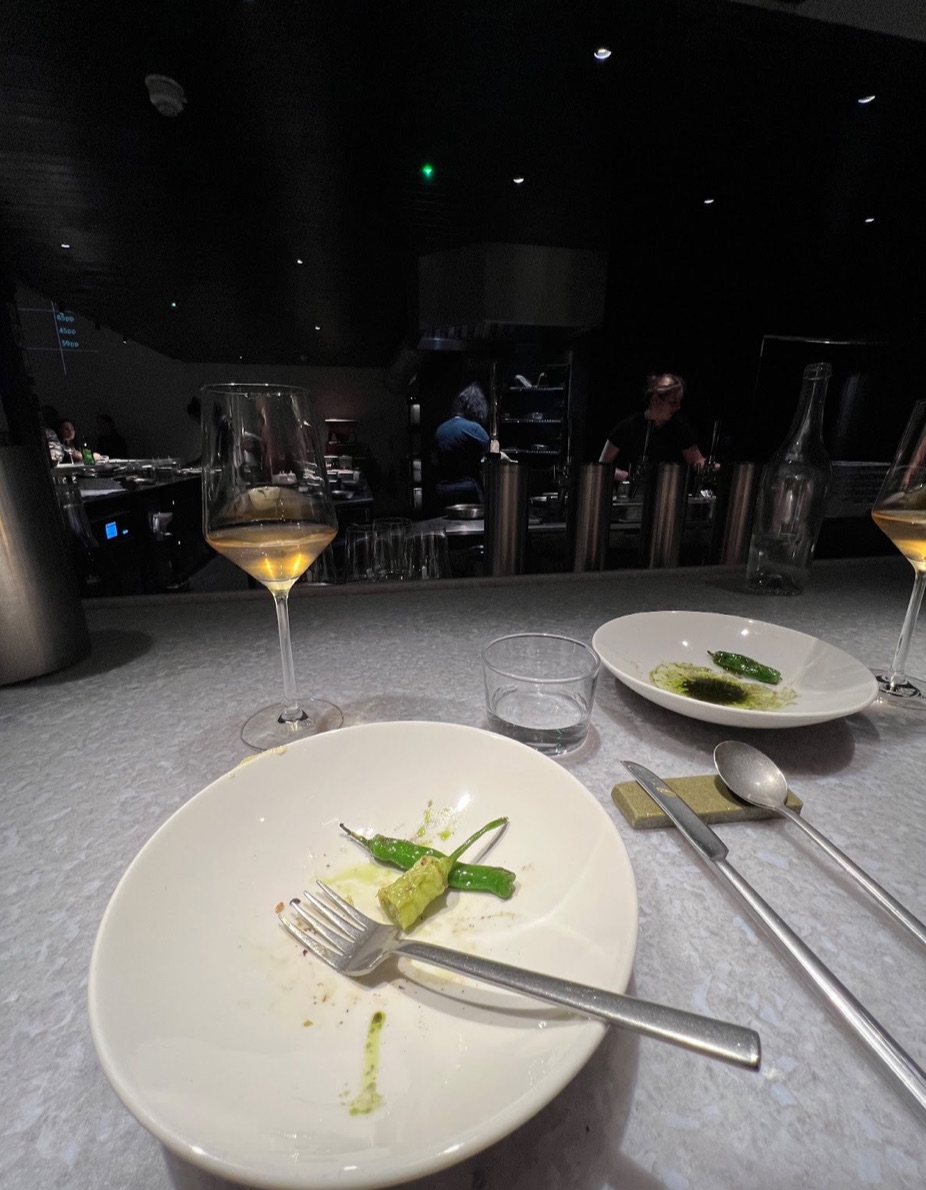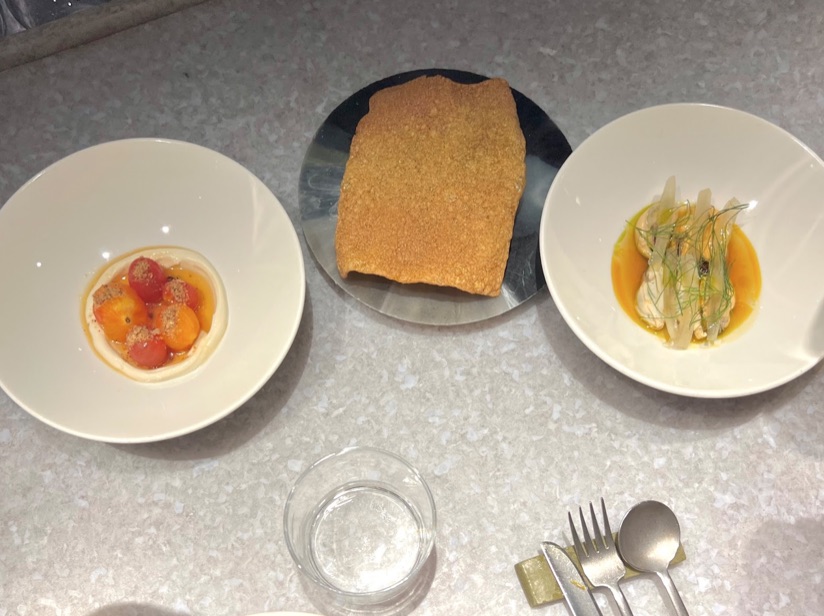
Last month, to celebrate our one-year anniversary, my partner and I had a lovely dinner at Silo, an intimate restaurant on the second floor of a renovated factory in East London. It was a Wednesday night, so we were able to get two seats at the counter with only a day’s notice. The kitchen, which was entirely visible from the counter, appeared to be mechanically consistent in the dishes they were producing at first glance.
The restaurant recently switched to a set menu comprising of eleven small dishes in total. As expected from the restaurant’s reviews, the food was amazing. Most of the dishes were made of just a few ingredients; highlights include the mussels with cucumber and fennel, wild rabbit dumplings, and tomato in smoked yogurt.
One of the perks of a set menu is that the staff can focus entirely on an individual task and make it the best it can be. One of the cooks spent the evening tending to the open-smoker full of various chicken parts, singing along to DeBarge’s “I Like It” alongside her coworker, who focused on pan-frying the Maitake mushrooms. At this point, the staff had been preparing this menu every night for over a month, and that experience was clear in the dishes. Each item was cooked to perfection and plated beautifully.
But enough about the admittedly fantastic food. Silo’s real claim to fame is its legacy of sustainability. When it opened in 2015 in Brighton, it was the world’s first “zero-waste” restaurant, meaning that every aspect of the dining production produces no trash for the landfill and requires no high-temperature destruction. The food is sourced directly from farmers who use zero-waste techniques and is shipped entirely in reusable containers through emission-free methods. My favorite fun fact from our waiter was that the “pirate” amazake, a fermented rice dish, got its name because the vanilla was imported from Portugal on an old-fashioned pirate ship.
Sometimes, the zero-waste method involves making food in-house. The first course, the “Siloaf” bread, is milled on-site. Somewhat poetically, the final course, an ice cream sandwich, was breaded in the leftover crumbs from the Siloaf process. Chicken bones are turned into broth, and the Padron peppers are drizzled in a sauce that had been fermenting for six months, made up of the remaining parts of cuttlefish from the winter menu. And, of course, any leftovers that are not reincorporated into a new dish are composted.
The “set menu” model is not just beneficial to the quality of the dishes but also the zero-waste mission. There is no risk that one dish will undersell and create extra trash at the end of the night. Silo can predict exactly how much of an item to order, which is ultimately a big key to sustainable dining: the will and ability to plan ahead. The recently renovated restaurant is also made up of mostly recycled materials, including plates made from plastic bags and light fixtures formed from broken wine bottles. Nets on the ceiling hold up thick organic insulation to prevent the use of heating or cooling. When the staff began to clean up at the end of the night, they did so using very little water and no chemical cleaners.

So what can we learn from Silo’s sustainability model, and how can some of these lessons be applied to an institution like Wesleyan? Silo is a fine dining venue. Dinner is 65 GBP per person ($79.56 at the time of writing), not to mention the wine, which can be anywhere from 42 to 500 GBP per bottle. I figure it’s best to be upfront about exactly how much I paid for this, and also the fact that the dinner was a gift from my parents and I wouldn’t have been able to pay for it myself. Silo’s business model is undoubtedly made possible partly by its high-paying clientele, and some of its more specific techniques are not realistic for those with fewer resources. Yet there is still much that Wesleyan can learn from Silo, firstly because Wesleyan is a well-endowed institution with plenty of students and donors who can afford to eat at places like Silo, and secondly because a movement towards “zero waste” often comes from changes in discipline and mindset.
As mentioned earlier, Silo’s success is partly the result of careful planning. Sustainable practices are one thing, but those administering those practices must be organized and consistent with an eye on the future. It also needs to be accessible and easy for the consumer: Eco2Go containers and compost bins don’t matter nearly as much if it is difficult to use them. Sustainable practices can’t just be the morally right choice but should also be the easiest choice. At Silo, you step into the restaurant with relatively little control over what food is in front of you, hopefully understanding that it was harvested and made sustainably. There is no need to browse a menu to determine the most ethically sourced dish. The same goes for cooking practices. Menus should change depending on what foods are in season at that time, and weekly schedules should be based on what ingredients there is a surplus of to decrease what ends up in the trash.
Wesleyan is notably strong in sourcing its foods from local farmers and producers, a practice that is also key to the Silo model. Bon Appétit (Bon App), the company that runs food services out of Usdan and Summerfields, requires chefs to source at least 20% of their produce from farmers within 150 miles, part of its “Farm to Fork” program, which has existed since 1999. Bon App also commits to sourcing sustainable, humane, and antibiotic-free animal products while always offering vegan options at meal times. Universities should focus on increasing the portion of their produce coming from nearby, sustainable suppliers and encourage other institutions to do the same.
If you are in London and have the means and opportunity to do so, I would absolutely recommend a dinner at Silo. The service is fantastic, and the staff are happy to answer any questions about the process behind your meal. The restaurant itself is beautiful: minimalist without sacrificing personality or warmth. Though somewhat less comfortable than the tables, I’d suggest sitting at the counter if you go there on a date. Seeing the chefs working up close is fascinating and can stimulate interesting conversations. I’d suggest ordering the Atelier Kramar 2021 “Primaro” Rebula if you like fruity but subtle skin-contact wines. Afterward, grab a drink at one of the many hipster bars in Hackney Wick and walk along the canal while you digest.
Silo London: Unit 7, The white building, 1st Floor, c/o CRATE Bar, Unit 7 Queen’s Yard, London E9 5EN, UK
Price: 65 GBP per person plus drinks
Ethan Geiger can be reached at egeiger@wesleyan.edu.



Leave a Reply